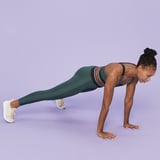
You've got your jumping jacks dialed, and you know how to do a plank . . . but have you tried plank jacks? This intermediate bodyweight move has likely cropped up in your workouts at some point - and whether you loved or hated it, it has some impressive benefits.
You get all the strength benefits of a plank (think: a strengthened core, shoulders, back, and legs) plus the benefits of cardio. All this, using just your body weight.
That said, plank jacks are not easy, and it's important to do them right so you don't increase your risk of injury. In some cases, that can mean modifying the move to a low-impact version. To help you do exactly that, keep reading for how to do plank jacks correctly, plank jack variations to try, and tips for incorporating them into your workout routine.
Benefits of Plank Jacks
This core-plus-cardio move will get you sweating, raise your heart rate, work your arms and legs, and build strength in your core. Add a resistance band around your legs, and you'll fire up your glutes as well. Yes, this simple bodyweight move can do all that.
Take it from F45 Training trainer Cristina Chan: "Plank jacks are a combined cardio and core-strengthening exercise that helps increase core strength and stability as well as cardiovascular strength." Reminder: Core stability is hugely important whether you're a pro athlete or just going about your daily life since it creates a stable base from which your limbs can move safely and effectively.
Because plank jacks offer a way to get your heart rate up without equipment or even standing up, they're a great cardio option for those who are working out at home or want to stay off their feet due to injury or space.
How to Do Plank Jacks
No matter which type of plank jacks you try, be sure to: keep your shoulders over your wrists, your hips down, your arms locked out, and your core engaged, Chan says. Because this is a pretty difficult move, it's a great option to incorporate into HIIT workouts or when you want to do some cardio at home. You can try it for the indicated number of reps below, or try it for a set amount of time: for example, a 30-second interval of work followed by 30 seconds of rest.
Here's how to do the classic version of plank jacks:
- Start in plank position, with your shoulders over your wrists, your body in one straight line, and your feet together.
- Like the motion of a jumping jack, jump your feet out wide and then back together. Try to keep your pelvis steady and don't let your hips rise toward the ceiling or dip toward the floor.
- Do a total of 30 jumping jacks. That's one set. Do 3 sets total.
Plank Jack Variation: Low-Impact Plank Jacks
Whether you're a beginner, returning to workouts after a break, or dealing with an injury, this low-impact variation of plank jacks is a great place to start.
- Start in plank position, with your shoulders over your wrists, your body in one straight line, and your feet together.
- Step your right foot out to the side, then your left foot out to the side.
- Then step your right foot back to center, and your left foot back to center.
- Try to keep your pelvis steady (don't let it rock from side to side) and don't let your hips rise toward the ceiling or dip toward the floor.
- Alternate which foot you start with for each rep.
- Do a total of 20 reps. That's one set. Do 3 sets total.
Plank Jack Variation: Resistance Band Plank Jacks
Add a mini resistance band or hip band around your thighs (easier) or ankles (harder) to recruit your glutes more during this move. If jumping your feet out is too difficult, try stepping your feet out like in the low-impact version explained above. (You'll still feel it in your glutes and core, promise.)
- Start in plank position, with your shoulders over your wrists, your body in one straight line, and your feet together. Loop a small resistance band around both legs.
- Jump your feet out wide, resisting the pull of the band, and then back together. Try to keep your pelvis steady and don't let your hips rise toward the ceiling.
- Do a total of 20 reps. That's one set. Do 3 sets total.
